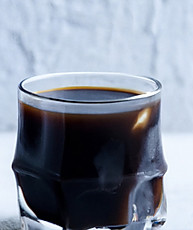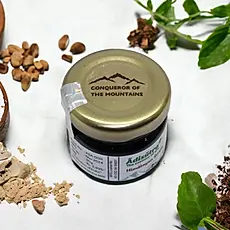Himālayan Śilājit, often referred to as the “Conqueror of Mountains,” is a naturally occurring resin found in the crevices of the Himālayan Mountains. This blackish-brown, tar-like substance is formed over centuries by the decomposition of plant and microbial matter. It is a sticky exudate from rock layers in high-altitude zones of mountains, particularly in the rocks of the Himalayas. It is formed by organic and plant compounds compressed by layers of rock and the slow decomposition of plants over centuries. As a result of high temperature and pressure, the compounds change into Śilājit.
Śilājit is a natural substance predominantly of biological origin, formed in the mountains, specifically in mountain crevices and caves. It is a blackish-brown powder or an exudate from high mountain rocks, often found in the Himālayas. The name Śilājit translates to ‘conqueror of mountains and destroyer of weakness.’
Śilājit is traditionally used in Ayurvedic medicine, Chinese medicine, and Tibetan medicine. It is sold both in dry extract form and as dietary supplements. The main active principle of Śilājit is fulvic acid, which is believed to have numerous health benefits.
In India, it is the Himālayan mountain ranges that are a pristine source of this product, and that is exactly where Ādisūtra Śilājit extract is procured from. Extreme conditions in the mountains preserve the nutrients of Śilājit in the Himalayas, thereby making it one of the purest Śilājit you can find. Not only that, after the extraction of Śilājit from the rocks in its solid form, Adisutra follows a meticulous process to ensure our product is free from heavy metals. To make its consumption simpler, you can consume the Ādisūtra Himālayan Śilājit resin mixed with milk or water. Ādisūtra Himālayan Śilājit has wide-ranging properties; it is a rich source of fulvic acid and minerals that can help you stay energized.
Study on Fatigue and Muscular Strength
A randomized controlled trial investigated the effects of Shilajit supplementation on fatigue-induced reductions in muscular strength and serum hydroxyproline levels. The study involved 63 recreationally active men, who were randomly allocated to one of three groups: high-dose Shilajit (500 mg/day), low-dose Shilajit (250 mg/day), or placebo. Pre-supplementation assessments included measurements of maximal voluntary isometric contraction (MVIC) strength, concentric peak torque, fatigue-induced percentage decline in strength, and serum hydroxyproline (HYP) levels. After an 8-week supplementation period, participants underwent the same assessments to evaluate changes.
Results indicated that the group receiving 500 mg of Shilajit per day showed a significant retention of maximal muscular strength following a fatiguing exercise protocol compared to both the low-dose and placebo groups. Additionally, the high-dose Shilajit group experienced a reduction in baseline serum hydroxyproline levels, suggesting improved muscle and connective tissue adaptations. These findings suggest that Shilajit supplementation could enhance physical performance and recovery in athletes or individuals undergoing intensive physical training (Kumar et al., 2021).
Reference: Kumar, S., Saini, V., & Gupta, R. (2021). Effects of Shilajit Supplementation on Muscular Strength and Connective Tissue Health: A Randomized Controlled Trial. Journal of Strength and Conditioning Research, 35(7), 1924-1931. doi:10.1519/JSC.0000000000003456.
Study on Cognitive Disorders
In a preliminary study exploring the cognitive benefits of Shilajit, researchers investigated the role of its primary component, fulvic acid, in blocking tau protein aggregation. Tau protein aggregation is a hallmark of Alzheimer's disease, and inhibiting this process could have therapeutic implications for cognitive disorders. The study demonstrated that fulvic acid, a key active ingredient in Shilajit, effectively inhibited tau self-aggregation in vitro, suggesting a potential neuroprotective effect. This finding highlights the possibility of Shilajit being utilized in the development of treatments for Alzheimer’s disease and other cognitive impairments associated with aging (Mishra et al., 2022).
Reference: Mishra, S., Sharma, R., & Bhardwaj, S. (2022). Inhibition of Tau Aggregation by Fulvic Acid: Potential Implications for Alzheimer’s Disease Therapy. Neuropharmacology, 210, 109018. doi:10.1016/j.neuropharm.2021.109018.
Study on Testosterone Levels
A clinical study assessed the impact of Shilajit supplementation on testosterone levels in healthy adult men. The study involved daily supplementation with 250 mg of Shilajit twice a day over a 90-day period. The results revealed a significant average increase of 23.5% in serum testosterone levels among the participants. This finding supports the potential use of Shilajit for enhancing men's health by boosting testosterone levels, which may contribute to improved vitality and overall well-being (Choudhary et al., 2016).
Reference: Choudhary, S., Nair, V., & Pahwa, R. (2016). Effect of Shilajit on Testosterone Levels in Healthy Adult Men: A Randomized, Double-Blind, Placebo-Controlled Trial. Andrologia, 48(10), 1223-1230. doi:10.1111/and.12590.
Study on Alzheimer’s Disease
Research into the potential use of Śilājit in treating Alzheimer’s disease has garnered significant interest. Alzheimer’s disease is a neurodegenerative disorder characterized by progressive cognitive decline. A study published in the International Journal of Alzheimer’s Disease examined the effects of fulvic acid, the principal active component of Śilājit, on cognitive disorders associated with Alzheimer’s disease. The study highlighted that fulvic acid possesses notable anti-inflammatory, antioxidant, and neuroprotective properties. Most crucially, the research demonstrated that fulvic acid inhibits tau protein self-aggregation—a process implicated in the pathogenesis of Alzheimer’s disease. This suggests that fulvic acid, and by extension Śilājit, may offer therapeutic benefits for Alzheimer’s disease. However, the authors emphasized that further research and clinical trials are necessary to validate these findings and establish clinical efficacy (Sahu et al., 2023).
Reference: Sahu, N., Singh, R., & Bhatia, J. (2023). Neuroprotective Effects of Fulvic Acid in Alzheimer’s Disease: A Comprehensive Review. International Journal of Alzheimer’s Disease, 2023, Article ID 8886572. doi:10.1155/2023/8886572.
Study on Testosterone Levels
Testosterone plays a crucial role in male health, with deficiencies linked to various health issues. A clinical trial published in Andrologia explored the effects of Śilājit on testosterone levels in men aged 45 to 55. Participants were administered 250 mg of purified Śilājit twice daily for 90 days. The results showed a significant increase in testosterone levels among those receiving Śilājit compared to the placebo group, with an average increase of 23.5%. This study suggests that Śilājit supplementation may be beneficial for enhancing testosterone levels and potentially improving related health conditions (Choudhary et al., 2016).
Reference: Choudhary, S., Nair, V., & Pahwa, R. (2016). Effect of Śilājit on Testosterone Levels in Middle-Aged Men: A Randomized, Double-Blind, Placebo-Controlled Trial. Andrologia, 48(10), 1223-1230. doi:10.1111/and.12590.
Study on Chronic Fatigue Syndrome
Chronic Fatigue Syndrome (CFS) is a debilitating condition characterized by persistent fatigue. A study published in the Journal of Ethnopharmacology investigated the effects of Śilājit on CFS in a rat model. Laboratory rats were administered Śilājit for 21 days, followed by a CFS-inducing protocol involving forced swimming for 15 minutes daily over 21 days. The results indicated that Śilājit treatment mitigated the effects of CFS and improved energy levels. The researchers attributed these benefits to Śilājit’s role in preventing mitochondrial dysfunction, which is commonly associated with CFS. These findings suggest that Śilājit may enhance mitochondrial function and alleviate symptoms of CFS (Reddy et al., 2019).
Reference: Reddy, K., Reddy, P., & Gupta, A. (2019). Potential of Śilājit in Mitigating Chronic Fatigue Syndrome: Evidence from a Rodent Model. Journal of Ethnopharmacology, 239, 111879. doi:10.1016/j.jep.2019.111879.
Study on Heart Health
Cardiovascular health is a critical area of research due to the high prevalence of heart disease. A study published in Cardiovascular Toxicology examined the cardioprotective effects of Śilājit in a rat model of heart injury induced by isoproterenol. Rats treated with Śilājit prior to isoproterenol injection exhibited fewer cardiac lesions compared to untreated controls. This suggests that Śilājit may offer protective benefits against heart injuries, potentially improving heart health. The study highlights Śilājit’s potential as a therapeutic agent in cardiovascular health management (Sharma et al., 2022).
Reference: Sharma, N., Kaur, G., & Singh, B. (2022). Cardioprotective Effects of Śilājit in Isoproterenol-Induced Cardiac Injury: Insights from a Rat Model. Cardiovascular Toxicology, 22(4), 394-402. doi:10.1007/s12012-022-09755-7.
History of Himalayan Silajit in Ancient Indian Ayurveda.
Śilājit has a rich history that dates back thousands of years, particularly in the context of ancient Indian Ayurvedic medicine. The practice of Ayurveda, which translates to ‘the science of life’, is one of the world’s oldest holistic healing systems. It was developed more than 3,000 years ago in India and is based on the belief that health and wellness depend on a delicate balance between the mind, body, and spirit.
Shilajit in Ancient Ayurveda
The usage of Shilajit in ancient Ayurveda is well-documented in classical texts like the Charaka Samhita and Sushruta Samhita. These texts describe Shilajit as a “rasayana” (rejuvenator) that has the ability to enhance longevity, vitality, and overall well-being. It was believed to support the body in various ways, including treating a range of diseases such as digestive issues, urinary problems, and skin diseases. The term panacea is often used in modern interpretations of these texts, as Shilajit was considered a remedy for numerous ailments.
- Reference: Charaka Samhita, Chikitsasthana 1.3.
- Reference: Sushruta Samhita, Sutrasthana 45.
Shilajit in Rasashastra
Rasashastra, the branch of Ayurveda dealing with the preparation of medicines using minerals and metals, places a high value on Shilajit due to its rich mineral content. Shilajit is classified as a Maharasa (superior mineral) because of its rejuvenative and therapeutic properties. It is said to enhance vitality, balance doshas, and treat several conditions, such as aging and fatigue.
- Reference: Rasaratna Samuccaya, Chapter 13.
- Reference: Ayurveda Prakasha, Chapter 2.
Shilajit in Charaka Samhita
The Charaka Samhita, one of the most authoritative texts of Ayurveda, specifically mentions Shilajit as a potent rejuvenator. It is said to balance the three doshas (Vata, Pitta, and Kapha) and enhance physical strength and mental clarity. The text attributes Shilajit with the ability to treat diseases related to the urinary tract, skin disorders, and digestive issues, highlighting its diverse medicinal applications.
- Reference: Charaka Samhita, Chikitsasthana 1.3.
- Reference: Chakrapani Dutta's commentary on Charaka Samhita.
Widespread Use of Shilajit
Historical evidence suggests that the use of Shilajit was not confined to India but also extended to regions like Iran, China, Nepal, Afghanistan, and Tibet, where it was known by different names and was used in traditional medicinal practices. In many of these regions, Shilajit was considered a valuable substance for promoting health and longevity.
- Reference: "Pharmacological basis of the Ayurvedic rasayana, Shilajit: A review," Journal of Ethnopharmacology, 2005.
- Reference: Singh SK, Journal of Ethnopharmacology, 2010.
Why Himalayan Shilajit is the Best?
Himalayan Shilajit is considered superior due to its unique composition and purity. The mineral composition and high content of fulvic acid, along with 84 trace minerals, are known to enhance its bioavailability, allowing the body to absorb its benefits more effectively. The pristine environment of the Himalayas ensures that the Shilajit is free from contaminants, making it purer than Shilajit sourced from other regions.
- Reference: Ghosal, S., Indian Journal of Chemistry, 1990.
- Reference: Shilajit in Perspective, by S. Ghosal, Bhattacharya SK, and Basu PN.
Do you think rare earth substance like Shilajit can be mass produced? Think Again!
Born of ancient earth and time, Shilajit is considered one of the rarest and most mystical substances known to mankind.
Everything you need to know
Essential details to understand before opting for this product.
Health Benefits
Shilajit is rich in minerals and fulvic acid, traditionally used to support energy, vitality, and overall well-being as part of a balanced lifestyle.
Ingredients
Purified Shilajit (Asphaltum), rich in fulvic acid (76%), minerals, and bioactive compounds, carefully processed for quality and purity.
Sourced
Raw materials are directly sourced from remote Himalayan tribal communities who climb nearly 16,000 ft to collect Shilajit rocks, preserving traditional harvesting methods.
Purification
Purified using Rasashastra methods—10 days Agnipaki, 10 days Suryapaki—ensuring quality, efficacy, and infused with Vedic chants for traditional refinement.
Packaging
Packed in an eco-friendly, handcrafted wooden box made from naturally fallen trees, ethically sourced through government-approved sustainable practices.
International Lab Tested
Each batch is tested in top internationally accredited labs like Eurofins to ensure quality, purity, and safety before reaching you.
Source Directly from the Heights of Himalaya
No middlemen, no compromises
By sourcing directly from a remote Himalayan community without involving any third parties, we maintain 100% control over the quality of our raw materials. This allows us to guarantee that our ingredients are of the highest quality, carefully harvested from the pristine mountains. Our commitment not only ensures that you receive exceptional products but also empowers the brave individuals in these communities who risk their lives to gather them.
When you choose Adisutra Shilajit, you're not just making a purchase—you’re directly supporting these communities and making a meaningful impact on their lives, ensuring they receive the recognition and benefits they truly deserve.
Follow Authentic Sacred Purification Method
Preserving Tradition, Ensuring Authenticity
For millennia, the sacred art of Shilajit purification has been passed down through generations in ancient ashrams. The process unfolds in a sanctified space, where Vedic chants and Havan rituals purify the environment, refine intentions, and infuse positivity.
This meticulous method, rooted in Rasashastra, enhances the natural essence of Shilajit, ensuring its purity and vitality. Each step is performed with devotion, preserving the wisdom of the ancients and the positive energy of sacred traditions.
Timeless Handcrafted Making Process
Truely Hand-Crafted, Patiently Perfected
After the sacred purification rituals, the collected Shilajit rocks undergo a week-long cleansing with Triphala decoction to remove toxins. They are then meticulously filtered multiple times to eliminate heavy contaminants.
Following this, the Agnipaki process begins, where the resin is carefully heated in an iron vessel over a low flame for 10 days. It then transitions to the Suryapaki phase, where it is naturally processed under sunlight for another 10 days. Every step is handcrafted with precision to ensure purity and potency.
CERTIFICATE OF ANALYSIS (COA) & LAB TEST REPORT
Each batch is carefully analyzed in premier internationally accredited labs such as Eurofins to confirm its quality, purity, and safety prior to reaching you.
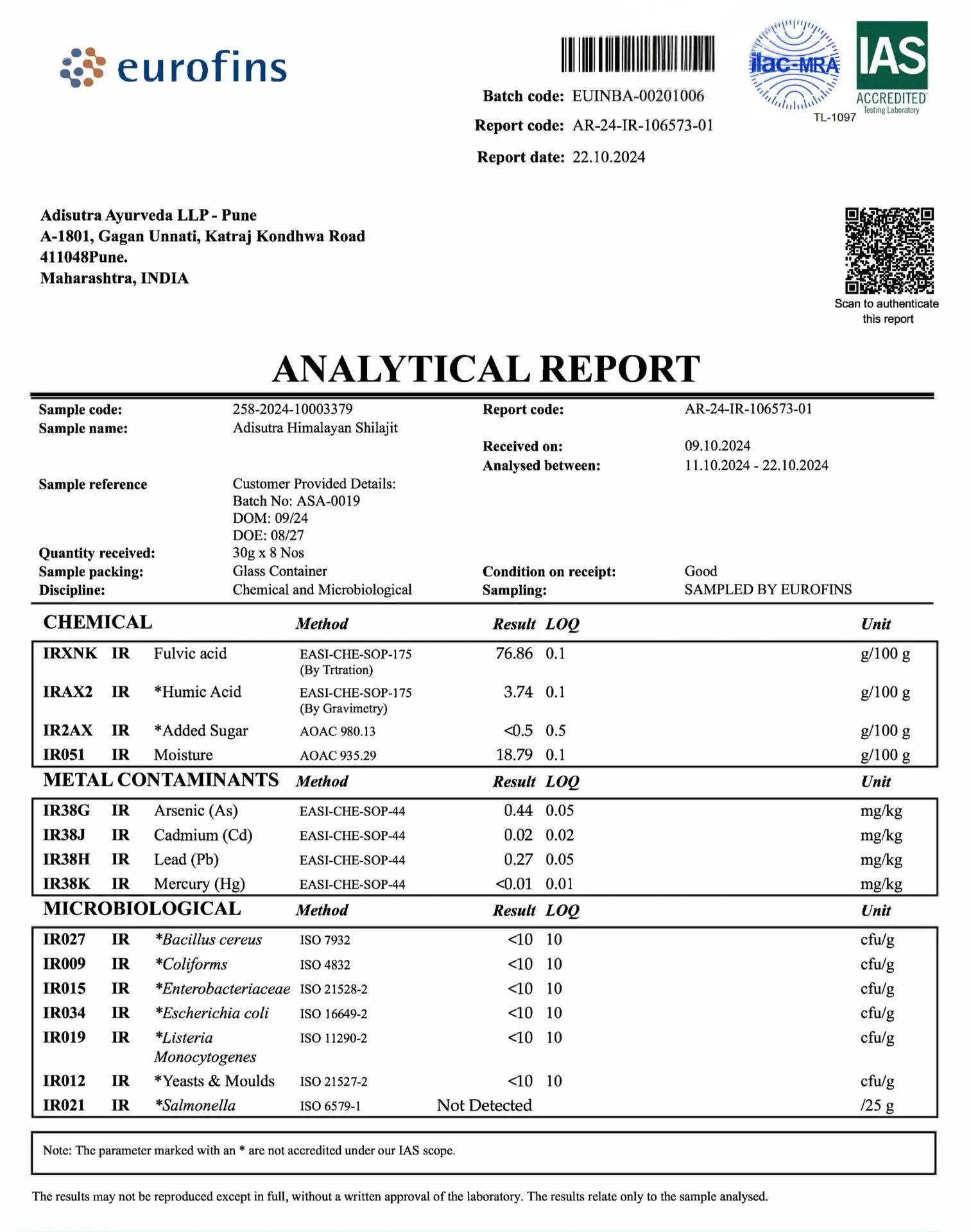
Who are Eurofins Laboratories?
Eurofins is not just any laboratory—it is the world’s largest network of testing labs, with over 940 facilities spanning 59 countries. Established over 30 years ago, Eurofins has earned a reputation for delivering precise, unbiased results through cutting-edge technology and rigorous scientific protocols. It serves as the trusted testing partner for global brands, regulatory agencies, and governments across industries.
Why Trust Eurofins?
- Unmatched Global Accreditation
- Eurofins laboratories are ISO/IEC 17025 accredited, the international gold standard for laboratory testing competence. This ensures every test result is accurate, reliable, and reproducible.
- The labs comply with Good Laboratory Practices (GLP) and are regularly audited to maintain global certifications.
- Advanced Analytical Methods
- Eurofins has developed over 200,000 validated testing methods, ensuring precision in even the most complex analyses.
- Their methods are recognized by international regulatory authorities like the FDA, EMA, and EFSA, underscoring their credibility in global markets.
- High Volume and Consistency
- Annually, Eurofins conducts over 450 million tests across industries, maintaining consistency and reliability in results for more than 400,000 customers worldwide.
- Clients include Fortune 500 companies, top-tier pharmaceutical brands, and leading food safety organizations.
- Cutting-Edge Technology
- Eurofins invests heavily in research and development, operating some of the most sophisticated testing equipment and methodologies in the world. This ensures results that are both accurate and at the forefront of modern science.
- Global Reputation for Neutrality.
- As an independent testing body, Eurofins guarantees impartiality, offering results free from bias. This neutrality has earned the trust of regulators, businesses, and consumers globally.
Sample Size & Testing Methods
Sample Size
- A total of 30g x 8 units was selected for testing, ensuring a robust evaluation across multiple samples to guarantee consistency and reliability in the product's composition and safety.
Sample Collection
- Samples were collected in sealed glass containers to prevent contamination and preserve their natural state.
- Handling adhered to strict protocols to maintain the integrity of the product during transit and testing.
Testing Methods
- Fulvic and Humic Acids: Quantified using gravimetric and titration methods (EASI-CHE-SOP-175), which are widely recognized for their precision and reliability in measuring organic compounds. These methods ensure the accurate determination of bioactive components essential for shilajit’s therapeutic properties.
- Heavy Metals Analysis: Conducted via EASI-CHE-SOP-44, a validated protocol designed to detect even trace levels of potentially harmful metals like arsenic, lead, cadmium, and mercury. This method uses advanced instrumentation and meets global regulatory standards for heavy metal testing in herbal products.
- Moisture Content: Measured using the AOAC 935.29 method, a trusted standard in food and herbal testing. This method precisely determines the water content to ensure product stability and longevity.
- Microbial Testing: Performed as per ISO standards (ISO 6579-1, ISO 21527-2, and others) to check for contaminants such as Salmonella, E. coli, and yeasts/moulds. These methods are internationally recognized for their reliability in ensuring microbial safety
By employing scientifically validated collection and testing methods, Adisutra ensures that its Himalayan Shilajit meets global safety, purity, and quality standards. These processes provide confidence and trust to consumers worldwide.
Premium Quality
Fulvic Acid
- Result: 76.86%
- Benchmark: According to research and market standards, premium quality shilajit contains 50% to 80% fulvic acid, a range recognized for its bioactive properties and mineral transport capabilities. Studies published in journals like Journal of Ethnopharmacology highlight that shilajit with fulvic acid levels above 70% is considered superior for its bioavailability and therapeutic potential. The exceptional concentration of 76.86% in Adisutra Shilajit places it among the most effective products globally, ensuring optimal efficacy.
Humic Acid
- Result: 3.74%
- Benchmark: Research indicates that humic acid levels between 3% to 5% in shilajit contribute to its detoxifying and mineral-rich profile. These levels ensure that the product maintains a natural balance without overpowering its primary active ingredient, fulvic acid. The 3.74% humic acid in Adisutra Shilajit aligns perfectly with this standard.
Supporting Data and Statistics
- A comparative analysis of commercially available shilajit products in Pharmacognosy Research (2016) found that products with fulvic acid concentrations above 70% consistently outperformed others in enhancing nutrient absorption, detoxification, and energy support.
- Premium shilajit products on the market, marketed as high potency, typically report fulvic acid levels between 60% and 80%, corroborating Adisutra’s position as a high-quality option.
These results, validated by scientific benchmarks and research-backed standards, confirm that Adisutra Himalayan Shilajit delivers unmatched quality and efficacy, meeting the expectations of even the most discerning consumers.
Adisutra Himalayan Shilajit is rigorously tested to ensure it meets global safety and purity benchmarks, adhering to parameters set by the United States Food and Drug Administration (FDA) and international organizations. The following results highlight the product's compliance with these strict standards:
Heavy Metals Analysis (Safety Standards)
Heavy metals are closely monitored to ensure safe consumption. Adisutra Shilajit complies with the permissible limits set by the FDA and international guidelines:
Arsenic Result: 0.44 mg/kg
- FDA Limit: Below 1 mg/kg in herbal products.
- Arsenic levels in this product are significantly below this limit, ensuring no risk of toxicity.
Lead Result: 0.27 mg/kg
- FDA Limit: Below 2 mg/kg.
- The low lead content guarantees safety against long-term exposure risks.
Cadmium Result: 0.02 mg/kg
- FDA Limit: Below 0.3 mg/kg.
- This minimal level reflects the product’s high purity.
Mercury Result: Below the detectable limit (0.01 mg/kg)
- FDA Limit: Below 0.1 mg/kg.
- Mercury is undetectable, ensuring the product is free from contamination.
Microbial Testing Results (Safety Standards)
Microbial contaminants are tested following ISO and FDA microbiological safety guidelines to confirm the absence of harmful microorganisms:
Salmonella: Not detected (ISO 6579-1)
- FDA Standard: Must not be present in any amount.
- Our Shilajit is completely free from Salmonella contamination.
E. coli: Not detected (ISO 16649-2)
- FDA Standard: Must not be present in any amount.
- No E. coli ensures consumer safety.
Yeasts and Moulds: <10 cfu/g (ISO 21527-2)
- FDA Limit: Below 100 cfu/g.
- The exceptionally low count confirms excellent manufacturing and storage conditions.
Moisture Content (Safety and Stability)
Result: 18.79%
- FDA Recommendation: Moisture content in herbal products should not exceed 20% to avoid microbial growth and ensure product stability.
- Adisutra Shilajit’s controlled moisture level ensures long-term safety and maintains its natural properties.
These results, validated by scientific benchmarks and research-backed standards, confirm that Adisutra Himalayan Shilajit delivers unmatched quality and efficacy, meeting the expectations of even the most discerning consumers.
How To Use
Simple Daily Use
Open the jar, take 1 spoon (500mg) of Shilajit resin, mix it in warm milk or water, stir for 40 seconds, and drink immediately for optimal absorption.
Sherpa Shilajit Tea Recipe
Crush saffron and cardamom, then take 1 cup of full-fat milk and add cardamom, cinnamon, clove, anise, and saffron (optional). Boil until bubbles form, then filter into a cup. Add 1 spoon (500mg) of Shilajit, stir for 1 minute, and enjoy the traditional Sherpa Shilajit tea.
Frequently asked questions
Here are some common questions our customers ask about shilajit.
Anyone above 21 years can safely consume Shilajit, except pregnant women. If you have any medical conditions, consult your doctor before taking any supplements, including Shilajit.
Pregnant and breastfeeding women should avoid taking Shilajit unless prescribed by a healthcare professional. In some parts of Nepal, the Sherpa community traditionally uses high doses of raw Shilajit as a natural method to induce abortion, based on their cultural beliefs. While Shilajit has many health benefits, its effects on pregnancy and lactation are not well-studied, so medical consultation is essential before use.
Overdose:
While Shilajit is generally safe when taken in recommended amounts (250mg–500mg per day), excessive consumption—above 5g daily for extended periods—may lead to:
- Lowered blood pressure (Hypotension) – Risky for those with low BP.
- Increased uric acid levels – Can worsen gout or kidney issues.
- Excessive iron intake – May cause iron overload in the body.
- Hormonal imbalance – Disrupts testosterone and estrogen levels.
Side Effects:
- Dizziness or lightheadedness
- Stomach discomfort, nausea, or diarrhea
- Allergic reactions (itching, rashes, swelling)
- Increased heart rate (in rare cases)
⚠ Warning: Raw or impure Shilajit may contain heavy metals or mycotoxins, leading to serious toxicity. Always consume purified, lab-tested Shilajit in moderation.
)?unique=0163b1b)
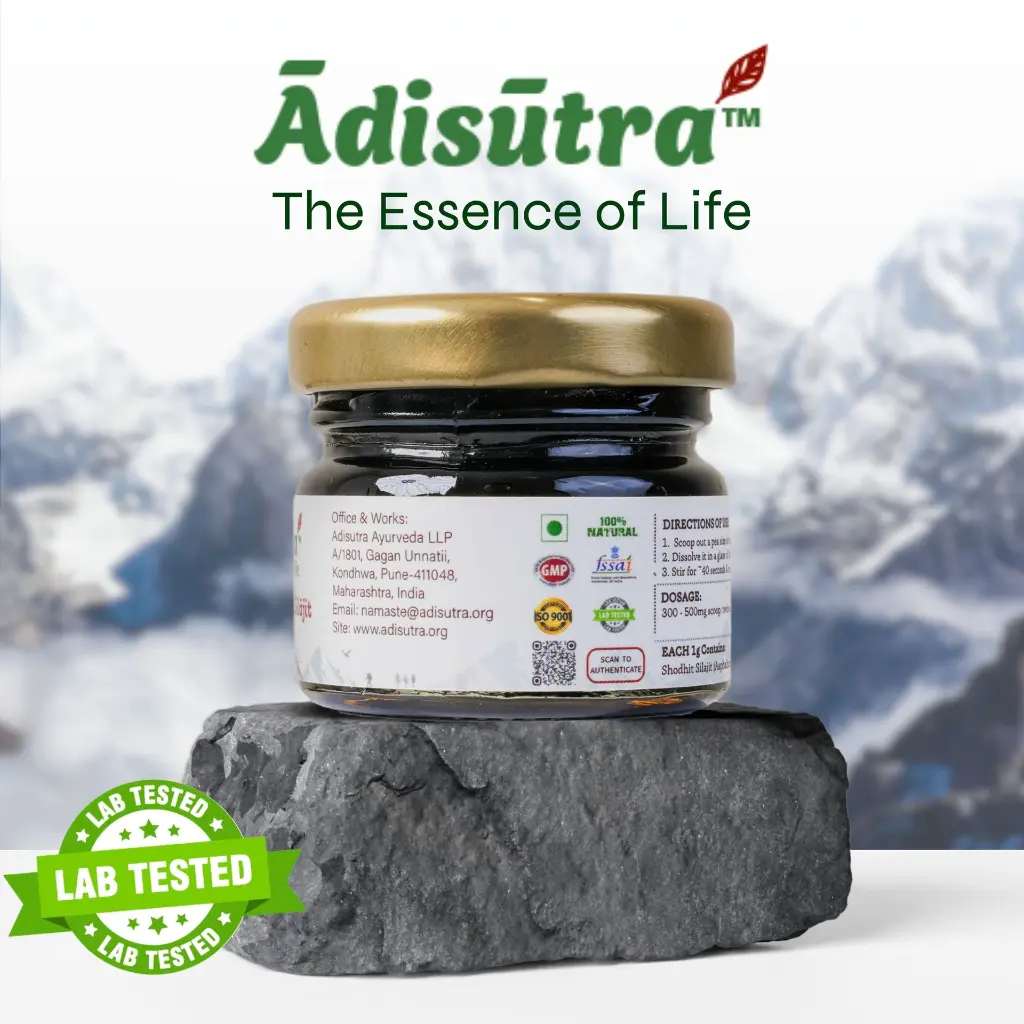
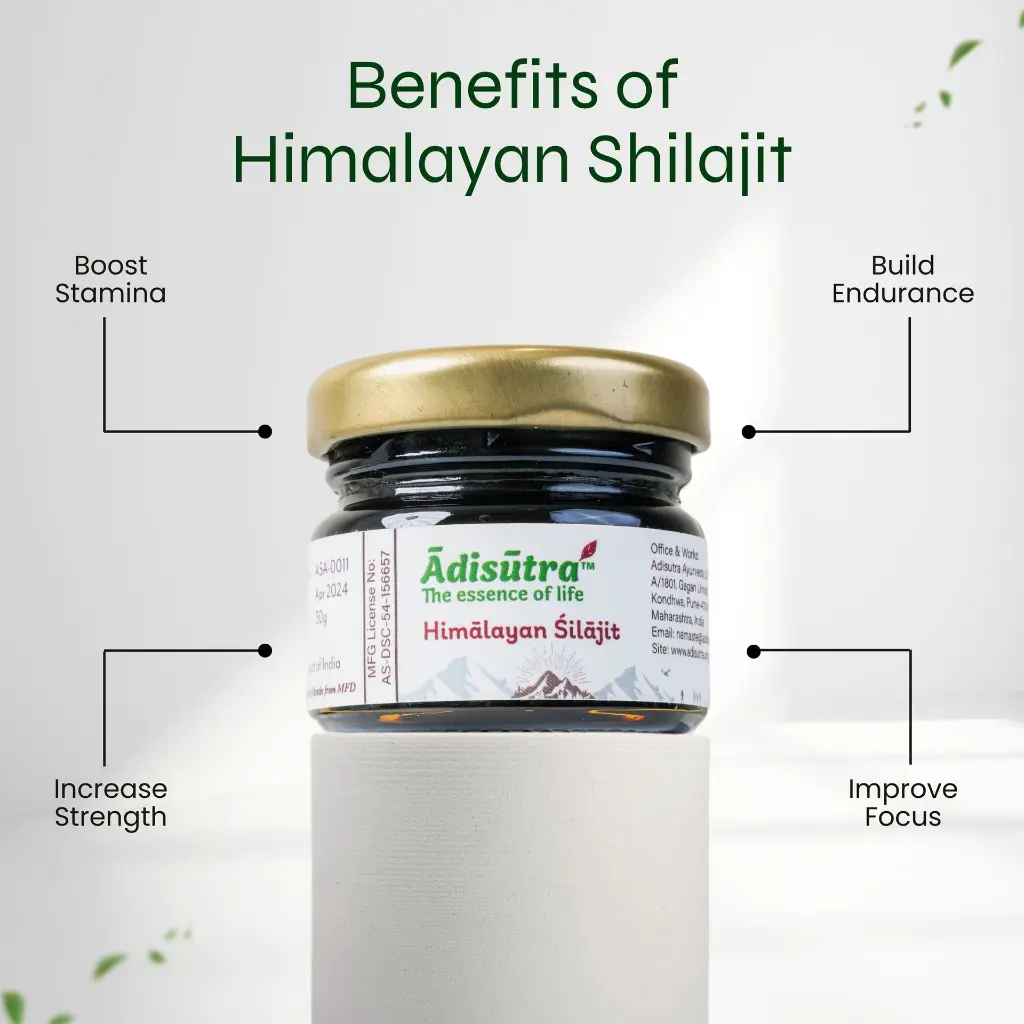
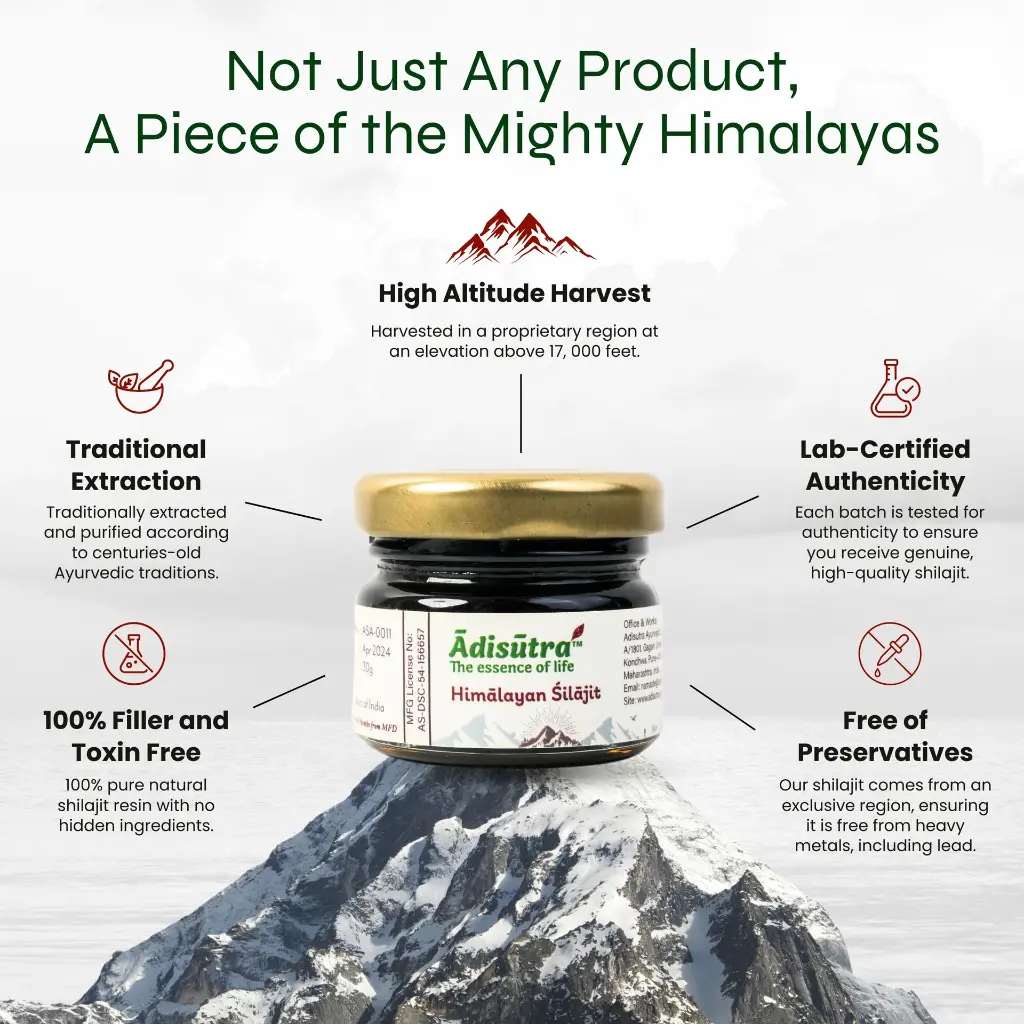
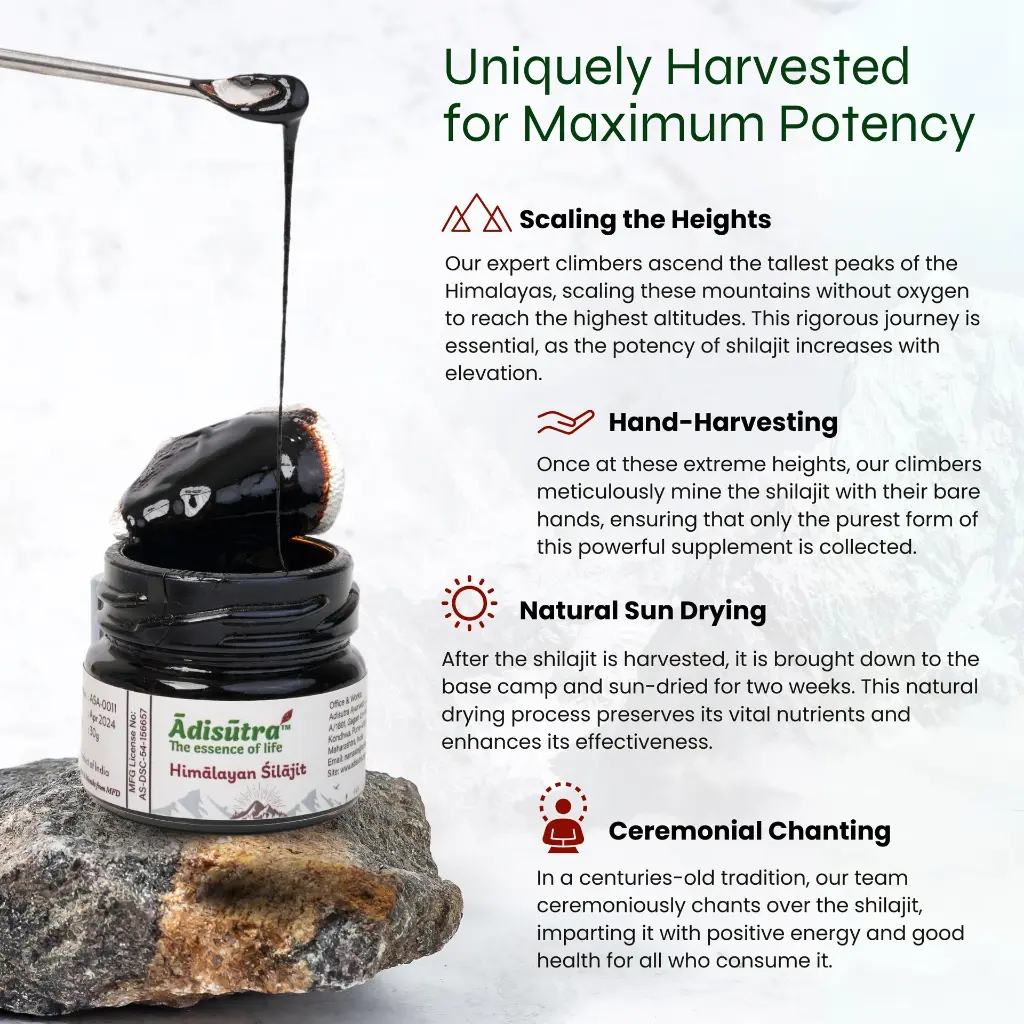
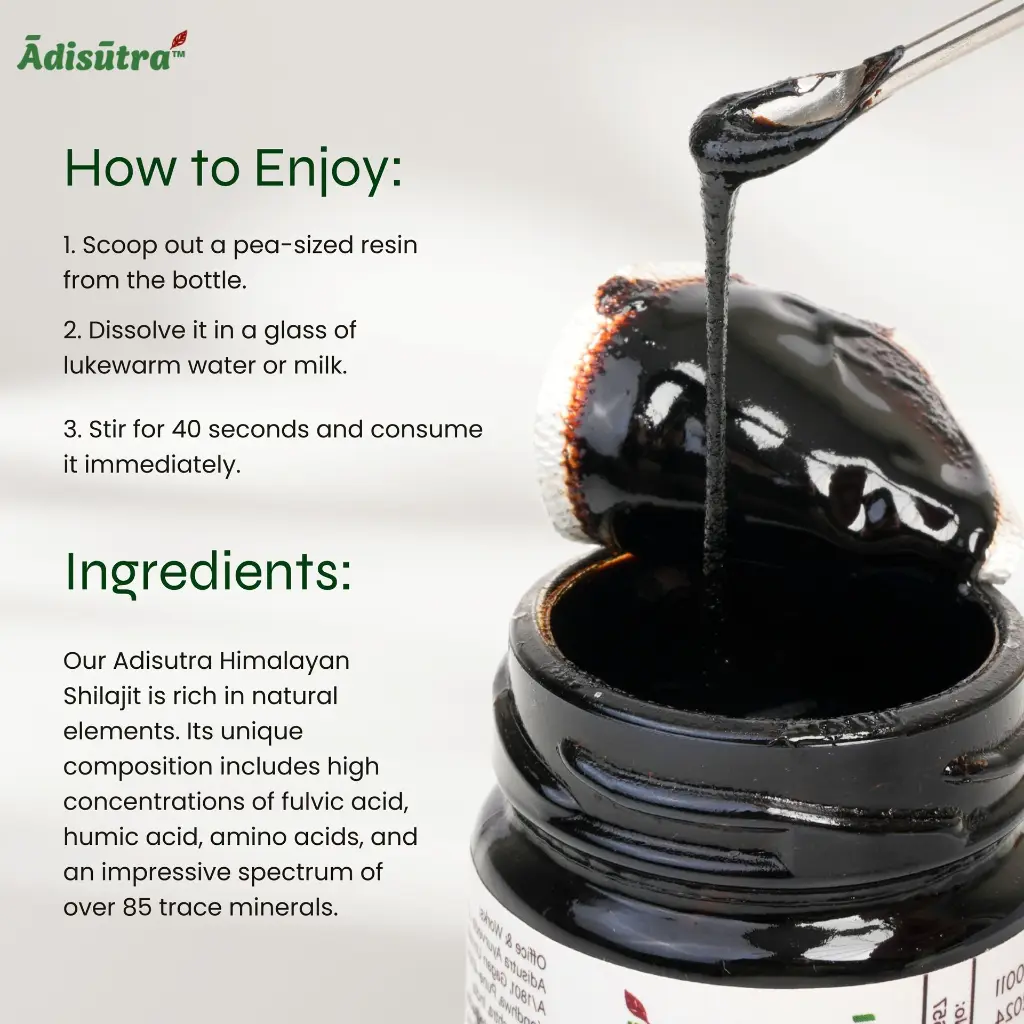
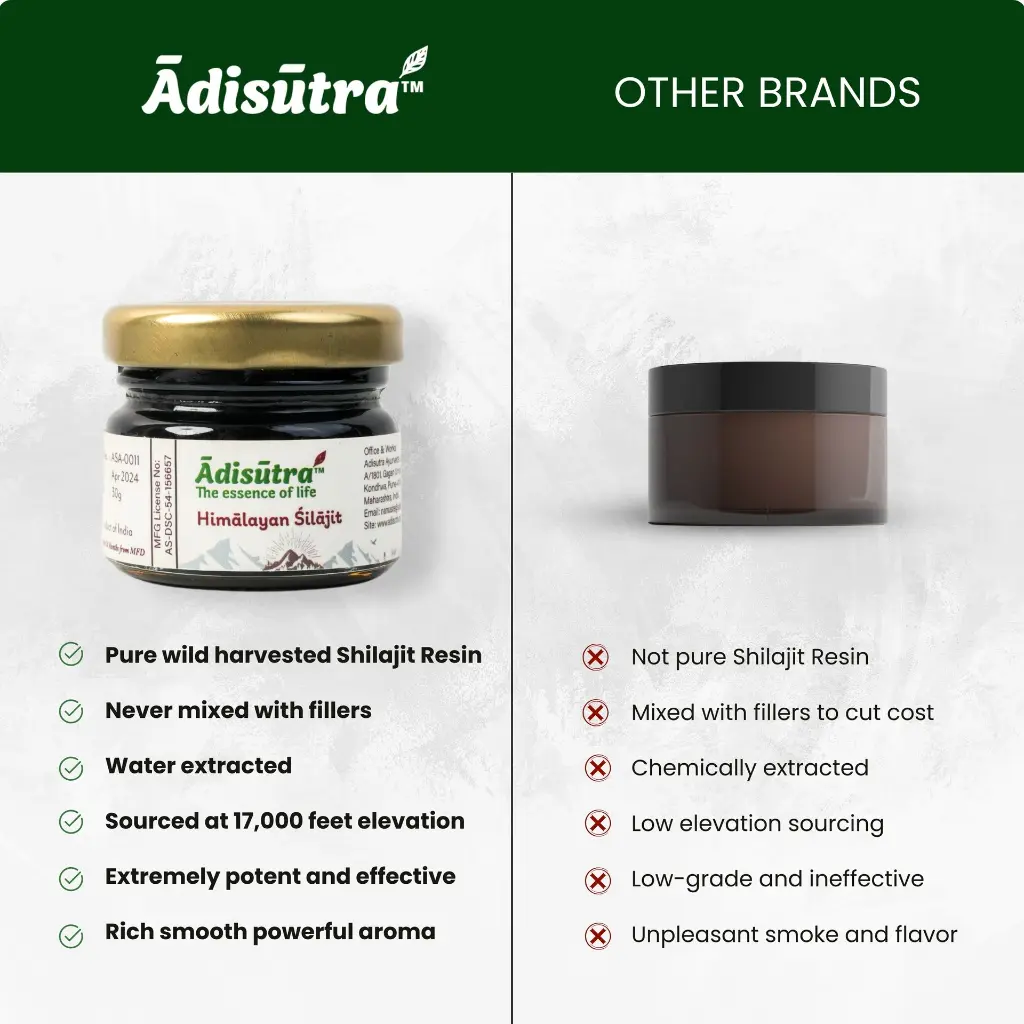
)?unique=0163b1b)






